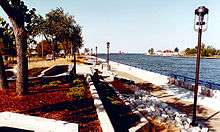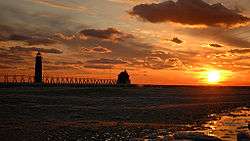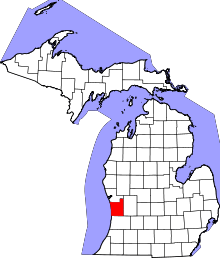Grand Haven, Michigan
| Grand Haven, Michigan | |
|---|---|
| City | |
| City of Grand Haven | |
|
The Grand Haven fog signal and inner lighthouse in February 2006. | |
| Nickname(s): "Coast Guard City U.S.A." | |
 Location of Grand Haven within Michigan | |
| Coordinates: 43°3′47″N 86°13′42″W / 43.06306°N 86.22833°WCoordinates: 43°3′47″N 86°13′42″W / 43.06306°N 86.22833°W | |
| Country | United States |
| State | Michigan |
| County | Ottawa |
| incorporated | 1867 |
| Government | |
| • Type | Council-manager |
| • Mayor | Geri McCaleb |
| Area[1] | |
| • Total | 7.36 sq mi (19.06 km2) |
| • Land | 5.77 sq mi (14.94 km2) |
| • Water | 1.59 sq mi (4.12 km2) |
| Elevation | 662 ft (202 m) |
| Population (2010)[2] | |
| • Total | 10,412 |
| • Estimate (2014[3]) | 10,965 |
| • Density | 1,804.5/sq mi (696.7/km2) |
| Time zone | EST (UTC-5) |
| • Summer (DST) | EDT (UTC-4) |
| ZIP code | 49417 |
| Area code(s) | 616 |
| FIPS code | 26-33340[4] |
| GNIS feature ID | 0627084[5] |
| Website | http://www.grandhaven.org |

Grand Haven is a city in the U.S. state of Michigan and the county seat of Ottawa County.[6] Grand Haven is located on the eastern shore of Lake Michigan at the mouth of the Grand River, for which it is named. As of the 2010 census, Grand Haven had a population of 10,412. It is part of the Grand Rapids Metropolitan Area, which had a population of 1,027,703 in 2014. The city is home to the Grand Haven Memorial Airpark (3GM) and is located just north of Grand Haven Charter Township.
History
The Potawatomi and Ottawa Indians lived in the area for centuries and used the river as a trade route into the interior of Michigan. Some of the long culture of the Ottawa tribe is being revealed through the excavation of archeological artifacts.
The city dates its European-American founding to French colonial settlers. A fur trading outpost called Gabagouache was first established by Madeline La Framboise and her husband Joseph.
After the War of 1812, this area became more settled by Americans. The first permanent resident was a Presbyterian minister, William Montague Ferry, who founded in 1834 the first area church and neighboring town of Ferrysburg. Residents named the town as "Grand Haven" in 1835. Sheldon Tannery was founded in 1838, developing to process leathers from the fur trade and cattle. The second church was organized in 1850. Ferry founded the city's first bank in 1851 in the Ferry & Son building on Harbor Drive. He also started a school, Ferry Elementary, which continues to operate. The city was incorporated in 1867.
In the mid-to-late 19th century, Grand Haven developed as a logging, lumber mill and shipping town, as well as a shipbuilding center.
The city was served by the Grand Trunk Railway, which ran along the waterfront near the river. Its depot and offices have been adapted for use as a historical museum. The Story and Clark Piano Company built pianos in the city from 1900-1984. The smokestack at the piano factory collapsed during the Southern Great Lakes Derecho of 1998. In August 2006, Eagle-Ottawa Leather Co., which developed from the 1838 Sheldon Tannery, announced it would close its local operations that year.
Given the importance of shipping and water trade to the city, the Grand Haven Lighthouses were built in 1839 on the south pier, to mark the most navigable channel into the river. The current lighthouses, painted red, were built in 1875 (outer light) and 1905 (inner). They are connected by a lighted catwalk, which runs along the pier to the shore.[7]
George "Baby Face" Nelson and Homer Van Meter, who became notorious 1930s criminals, committed their first bank robbery at a Grand Haven bank.
Business and tourism

The Grand Haven port community is an active beach resort with boating, fishing, sailing, biking, skating etc. along with connecting campgrounds and recreational areas. The city has over 100 miles (160 km) of bike trails, a state beach, boardwalk, two lighthouses, a pier, wharf, large charter fishing fleet and a Great Lakes port, where it imports limestone, slag, cement and coal while exporting sand. Grand Haven is a destination point for residents of inland cities of West Michigan, as well as many from the other side of the state. Grand Rapidians regularly visit to take advantage of the close proximity to the Lake Michigan beaches, State campgrounds, restaurants, bars, attractions with many even owning cottages in the area as their home away from home.
Grand Haven State Park was nationally recognized for having one of the top five beaches in the United States, by Good Morning America - Travel Mom. In summer, water temperatures do reach the low 70s°F (2013 had 19 days in the 70s),[8] bringing tens of thousands of visitors as a boon to the local economy.
The state park also includes a campground on Lake Michigan, near the pier and lighthouses. In addition, the city features a ski park (Mulligan's Hollow Ski Bowl) and a skate park. The waterfront locations bring tourists from all over the state and region for activities which include, boating, sailing, jet skiing, tubing, wind surfing, and an annual kite festival.
Grand Haven is home to the United States Coast Guard's "Sector Field Office Grand Haven." The first Coast Guard presence in the city was in 1924. The Coast Guard cutter Escanaba was based in the city until the Second World War. After it was sunk by a U-boat of Nazi Germany's Kriegsmarine, the citizens of Grand Haven raised more than $1,000,000 in bonds to build a replacement cutter bearing the same name; several pieces of wreckage remain displayed on the city's waterfront. Grand Haven hosts the annual Coast Guard Festival, a celebration based on Coast Guard Day, which draws U.S. and Canadian vessels along with parades of bands and other activities, including a memorial to the 101 sailors lost in the Escanaba sinking. The yearly attendance for this event exceeds 300,000 people over the two-week period of the festival. Grand Haven is the only city officially designated as Coast Guard City, USA by an act of Congress signed by President Bill Clinton. The act was Public Law 105-383 enacted by the United States Congress and signed by the president on November 13, 1998.
The Grand Haven Musical Fountain was built on the opposite bank of the Grand River from the city center in 1969. It plays nightly during the tourist season. When it was built, it was the world's largest such fountain. Today, the overall largest fountain is in Las Vegas.

Sports
Grand Haven is the home of the Lakeshore Cougars, a semi-professional football team and a member of the Football Great Lakes Football League.
West Michigan has been called the Midwest Mecca of beach volleyball due to the quality of sands. Grand Haven State Beach is one of many destinations for volleyball enthusiasts and hosts the AVP Pro Beach Volleyball Tournament throughout the summer months. In recent years, the beach has also become a destination for beach soccer, playing host to the largest of 12 annual Soccer in the Sand tournaments held throughout the country.
Grand Haven is also home to a golf course. The Grand Haven Golf Club was designed in 1965 by the legendary pioneer of Michigan golf, architect Bruce Matthews Sr. It has been featured in Sports Illustrated, Golf Digest magazines and on USA Network's "PGA Tour Sunday." It also gained national attention as being home to the LPGA's Shoreline Classic until recently.
Technology
Grand Haven has been one of many technology leaders in West Michigan and throughout the country, having been featured in the national media, including on ABC, in PCWorld, ComputerWorld and Forbes magazine.[9][10][11][12] The city was the first municipality in the country to feature a city-wide wireless internet service.[13] The wireless service is designed to work throughout the city and up to 15 miles (24 km) offshore for boaters. In 2004, the city started offering wireless internet service for residents, businesses and visitors for payment on varying cost-time scales.
Geography
According to the United States Census Bureau, the city has a total area of 7.36 square miles (19.06 km2), of which 5.77 square miles (14.94 km2) is land and 1.59 square miles (4.12 km2) is water.[1]

Education
Primary and secondary schools
- Grand Haven Public Schools
- Grand Haven High School
- Central High School
- White Pines Intermediate School
- Lakeshore Middle School
- Voyagers School
- Rosy Mound Elementary
- Robinson Elementary
- Peach Plains Elementary
- Mary A. White Elementary
- Lake Hills Elementary
- Griffin Elementary
- Ferry Elementary
- Private schools
- Grand Haven Christian School
- St.John's Lutheran School
Major highways
-
 US 31 runs through the city along a boulevard and utilizes a drawbridge over the Grand River at the northern city limit.
US 31 runs through the city along a boulevard and utilizes a drawbridge over the Grand River at the northern city limit. -
 M-104 runs easterly from US 31 in Ferrysburg, through Spring Lake and toward I-96.
M-104 runs easterly from US 31 in Ferrysburg, through Spring Lake and toward I-96.
Demographics
| Historical population | |||
|---|---|---|---|
| Census | Pop. | %± | |
| 1870 | 3,147 | — | |
| 1880 | 4,862 | 54.5% | |
| 1890 | 5,028 | 3.4% | |
| 1900 | 4,743 | −5.7% | |
| 1910 | 5,856 | 23.5% | |
| 1920 | 7,205 | 23.0% | |
| 1930 | 8,345 | 15.8% | |
| 1940 | 8,799 | 5.4% | |
| 1950 | 9,536 | 8.4% | |
| 1960 | 11,066 | 16.0% | |
| 1970 | 11,844 | 7.0% | |
| 1980 | 11,763 | −0.7% | |
| 1990 | 11,951 | 1.6% | |
| 2000 | 11,168 | −6.6% | |
| 2010 | 10,412 | −6.8% | |
| Est. 2015 | 11,062 | [14] | 6.2% |
2010 census
As of the census[2] of 2010, there were 10,412 people, 4,769 households, and 2,721 families residing in the city. The population density was 1,804.5 inhabitants per square mile (696.7/km2). There were 5,815 housing units at an average density of 1,007.8 per square mile (389.1/km2). The racial makeup of the city was 95.0% White, 0.7% African American, 0.9% Native American, 1.0% Asian, 0.4% from other races, and 1.9% from two or more races. Hispanic or Latino of any race were 2.4% of the population.
There were 4,769 households of which 24.8% had children under the age of 18 living with them, 42.1% were married couples living together, 11.0% had a female householder with no husband present, 3.9% had a male householder with no wife present, and 42.9% were non-families. 37.2% of all households were made up of individuals and 14.9% had someone living alone who was 65 years of age or older. The average household size was 2.15 and the average family size was 2.82.
The median age in the city was 42.9 years. 20.7% of residents were under the age of 18; 7.6% were between the ages of 18 and 24; 24.2% were from 25 to 44; 28.5% were from 45 to 64; and 19.1% were 65 years of age or older. The gender makeup of the city was 47.4% male and 52.6% female.
2000 census
As of the census[4] of 2000, there were 11,168 people, 4,979 households, and 2,892 families residing in the city. The population density was 1,923.5 per square mile (742.2/km²). There were 5,532 housing units at an average density of 952.8 per square mile (367.6/km²). The racial makeup of the city was 96.35% White, 0.45% African American, 0.56% Native American, 0.87% Asian, 0.02% Pacific Islander, 0.40% from other races, and 1.35% from two or more races. Hispanic or Latino of any race were 1.58% of the population.
There were 4,979 households out of which had children under the age of 18 living with them, 45.5% were married couples living together, 9.7% had a female householder with no husband present, and 41.9% were non-families. 34.8% of all households were made up of individuals and 14.2% had someone living alone who was 65 years of age or older. The average household size was 2.17 and the average family size was 2.81.
In the city the population was spread out with 20.1% under the age of 18, 9.2% from 18 to 24, 27.6% from 25 to 44, 23.4% from 45 to 64, and 19.6% who were 65 years of age or older. The median age was 40 years. For every 100 females there were 89.5 males. For every 100 females age 18 and over, there were 86.0 males.
Local Media
The area is served by the daily newspaper Grand Haven Tribune, headquartered in Grand Haven. The Tribune has a circulation of 9,497.
The city also has two radio stations, WGHN (AM) and WGHN-FM.
Economic data
The median income for a household in the city was $40,322, and the median income for a family was $50,000. Males had a median income of $34,846 versus $28,472 for females. The per capita income for the city was $22,274.
The median home cost in Grand Haven is $180,700. Home appreciation over the last year has been 2.20 percent. Homes directly on Lake Michigan cost considerably more than the median price though.
Grand Haven's cost of living is 6.10% lower than the U.S. average.
71.55% of the registered voters of Grand Haven are registered Republican, 27.64% Democrats, and the remaining 0.8% are independent.
Grand Haven public schools spend $6,588 per student, while the average school expenditure in the U.S. is $6,058. 19.85 percent of the city's population holds a four-year degree, compared with 15.16 percent nationally.
The unemployment rate is 12.6 percent. Recent job growth is positive and jobs have increased by 0.76 percent.
As of 2007, the area's major employers included:
- Herman Miller, Spring Lake
- Shape Corporation
- County of Ottawa
- Grand Haven Area Public Schools
- GHSP
- North Ottawa Community Hospital
- Meijer, Inc.
- Magna-Donnelly
- ASIMCO Technologies
- Alcoa Automotive Castings
- Wal-Mart
The city houses some of the courts for Ottawa County. Other offices are located in West Olive, Hudsonville and Holland Township. It manages its own fire and police departments and is the location of the lakeshore's power source, Grand Haven Board of Light and Power.
Notable people
- Howard Bailey, Major League Baseball pitcher
- Neal Ball, first player in Major League baseball to execute an unassisted triple play (accomplished in 1909)
- Dan Bylsma, former NHL player and coach
- BØRNS, indie-pop singer-songwriter, EP "Candy"
- Al Capone, infamous gangster, reputed to have owned a safe house in Grand Haven
- Gary Hogeboom, former NFL quarterback for Dallas Cowboys, contestant on CBS reality TV show Survivor: Guatemala
- Tom Izzo, current Michigan State Spartans Basketball coach, owns a home and spends his summers in Grand Haven
References
- 1 2 "US Gazetteer files 2010". United States Census Bureau. Retrieved 2012-11-25.
- 1 2 "American FactFinder". United States Census Bureau. Retrieved 2012-11-25.
- ↑ "Population Estimates". United States Census Bureau. Retrieved 2013-06-03.
- 1 2 "American FactFinder". United States Census Bureau. Retrieved 2008-01-31.
- ↑ U.S. Geological Survey Geographic Names Information System: Grand Haven, Michigan
- ↑ "Find a County". National Association of Counties. Retrieved 2011-06-07.
- ↑ "Historic Light Station Information and Photography: Michigan". United States Coast Guard Historian's Office. Retrieved 2014-07-21.
- ↑ "SurfGrandHaven.com -Grand Haven Weather - Grand Haven Surf Cam - Grand Haven Info - Grand Haven Services - Grand Haven Businesses - Water Temperature". surfgrandhaven.com.
- ↑ "Grand Haven, Here We Come - ABC News". Retrieved 21 July 2014.
- ↑ Kotkin, Joel. "Small Cities Are Becoming New Engine Of Economic Growth". Retrieved 21 July 2014.
- ↑ Brewin, Rob. "Michigan city turns on citywide Wi-Fi - Computerworld". Retrieved 21 July 2014.
- ↑ "Michigan City Goes Wireless". PCWorld. Retrieved 21 July 2014.
- ↑ "High Tech Marketing Firms - High Tech PPC and SEO Firms - Chicago Web Design". walkersands.com.
- ↑ "Annual Estimates of the Resident Population for Incorporated Places: April 1, 2010 to July 1, 2015". Retrieved July 2, 2016.
- ↑ "Census of Population and Housing". Census.gov. Retrieved July 1, 2016.
External links
| Wikimedia Commons has media related to Grand Haven, Michigan. |

